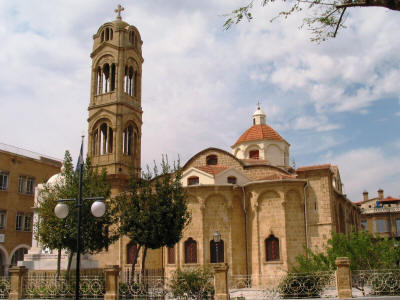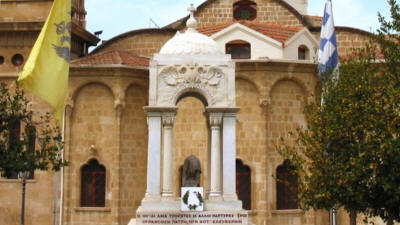Phaneromeni Church
Nicosia, South Cyprus
 |
| Phaneromeni Church |
Phaneromeni Church is closely identified with Nicosia. According to historical references it dates from 1300AD. However the church in its present form was built in 1872-3. In 1938 a new bell tower was added, and its bells brought from England in 1940-41.
The church was named after a nunnery of the same name which once stood on this spot, and dates back to the early 14th century. It belonged to Panayia (Virgin Mary) Phaneromeni, and the nuns were silk weavers who were engaged in charitable works.
There is an interesting story surrounding the name. Legend has it that during one of several renovations, the icon of Panayia, which had been stolen, revealed itself following a vision. Phaneromeni means "that which is revealed".
After the occupation of Cyprus in 1571, the Ottomans attempted to turn the church into a mosque. They were unsuccessful, however, since all the imams appointed there mysteriously died soon after taking up their duties!
What really characterises Phaneromeni church is its interior The magnificent wood-carved iconostasis (the screen that separates the nave from the apse) dates back to 1659. It is engraved with representations from the old testament, and is adorned with old icons bearing rich illustrations.
|
|
| The Iconostasis and Alter |
Among the precious icons of the church are those painted by the famous Greek artist Kissonergis, including the “Platytera” at the pulpit, the Pantocrator” and the four Evangelists at the dome. The ancient icon of the Holy Virgin, after which the church is named, is kept at the Byzantine Museum in Nicosia. A copy of this magnificent icon, a remarkable artistic treasure in itself was painted by the well known Cypriot painter, Adamantios Diamantis, in 1924, and adorns the iconostasis of the church today. It is covered in silver, with a gold plated cover made in 1851.
The alter and Holy Throne were made by the well known Cypriot wood engraver, Artemis Papadopoulos. The pulpit was the work of wood engraver Taliadoros.
In the early 19th century, Archbishop Kyprianos was head of the Cypriot orthodox Church. In 1814, Greek nationalists on the mainland formed a secret organization called the Friendly Society (Filiki Eteria), and the Archbishop was initiated into this organisation in 1818. With the support of wealthy Greek exile communities in Britain and the United States, the aid of sympathizers in Western Europe and covert assistance from Russia, they planned a rebellion in order to gain independence from the Ottomans. The start of the uprising can be set in 6th March 1821 when several Greek officers of the Russian army crossed the river Prut in Romania. Simultaneous risings were planned across Greece, including in Macedonia, Crete and Cyprus.
Archbishop Kyprianos, along with other clergy and leading Christians, were discovered to have connections with Filika Eteria. The response of the governor was swift and bloody. The archbishop, three bishops, and many prominent Christians were executed for treason.
 |
| The Mausoleum |
In 1930, a mausoleum was built in the courtyard of Phaneromeni church. This serves as a repository for the relics of Archbishop Kyprianos, and the other Greek Cypriots executed on the 9th July 1821.These relics are in a shrine under the mausoleum.
However the church's involvement in terrorists activities does not end here. In December 1955, the EOKA gunman, Mouskos, had been killed during an aborted ambush of British military personnel. Because Archbishop Makarios was his cousin, he conducted his funeral service at Phaneromeni church. Crowds of Greek Cypriots turned out, and students from the Pancyprian Gymnasium (Where former students included Makarios and Grivas), sang nationalistic songs. After the funeral, the crowds refused to disperse peacefully, and only left the area after the use of tear gas.
In the 1950s, the head priest of Phaneromeni church, Papastavros, worked closely with the Bishop of Kyrenia, indoctrinating Greek Cypriot youths with anti-British propaganda, and encouraging them to join EOKA. He delivered the EOKA oath to his recruits, and is believed to be its author.
Papastavros' role in the conspiracy is said to be second only to Makarios, and he acted as an intermediary between Grivas and Makarios. In March 1956, he was arrested in Kyrenia, and joined Makarios in exile in the Seychelles.
See the location in Google maps
Back to South Nicosia Index